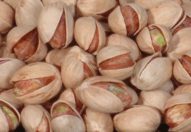Yazd Green Diamond Co.
(Motaabed Trading)


Pistachio
History - Growing
- Folklore
Medical
Benefits - Nutrition
- Storage
- Serving
- Raw
The original homelands of the pistachio were Asia Minor (now Turkey), Iran, Syria, Lebanon and a bit north to the Caucasus in southern Russia and Afghanistan.
Archeologists have found evidence in a dig site at Jarmo, near northeastern Iraq, that pistachio nuts were a common food as early as 6750 BCE. Then, for unknown reasons, these nuts fell into obscurity until 2000 BCE when the Near East sprouted in population and less common foods such as pistachios were rediscovered and even cultivated. The hanging gardens of Babylon were said to have contained pistachio trees during the reign of King Merodach-baladan about 700 BCE.
In the rocky hills of Palestine and Lebanon, pistachio trees grew wild, their treasured fruits picked and eaten raw or brought home and fried with salt and pepper. Not much went to waste in ancient times. Even the oil from the pistachio was pressed and used for cooking as well as for flavoring desserts.
The delightful green nutmeats had prominence in tasty, historical desserts such as Baklava, Nougat, and Turkish Delight where they served as a major ingredient. In biblical times chopped pistachios were added to fruit compotes, puddings, and stuffings, while the nuts in their ground-up form added body and flavor to many savory sauces. Today, pistachios are a familiar American snack, while in Iranian cooking, the nuts are often added to rice dishes along with raisins or currants, herbs and saffron.
In the first century AD the pistachio made its debut in Rome via the Emperor Vitellius. Apicius, Rome's Julia Child of the period, mentions pistachios in his classical cook book but denies us any of the recipes in which he includes them. The nuts traveled from Syria to Italy in the first century AD and spread throughout the Mediterranean from there.
The Persians used the pistachio abundantly, not only for desserts, but also in ground-up form to thicken and enhance sauces. The Arabs learned a few culinary secrets from the Persians and included pistachios in their dessert delicacies such as Baklava, a rich treat made from buttered filo dough alternately layered with nuts and bathed in a sweet syrup after baking. Pistachios were willing travelers and held up well on distant journeys, trekking from Persia to China via the Silk Route.
When the Arabs settled in the southern part of Spain, known as Andalusia, and in Sicily during medieval times, they introduced many foods from their native lands. Because pistachios were one of the foods the Arabs longed for, they transported either seeds or pistachio trees to these regions. The pistachios grown in Italy took on a very deep green color, were highly prized, and brought the best prices.
By the time pistachios were imported into Europe on a regular basis during the Middle Ages, they were quite expensive and not everyone could afford them. However, in spite of their high cost, merchants of France had an ample supply for anyone willing to splurge on the green wonders. During the 16th century pistachios arrived in England where they were not a raging gastronomic success.
California encountered the pistachio in 1854 when Charles Mason, a seed distributor for experimental plantings, brought the pistachio to this country. Several years later, in 1875, a few small pistachio trees imported from France were planted in Sonoma, California. In the early 1900's Chico, California, became the home of the first experimental Plant Production Station. Funded by the USDA, this station brought in a variety of pistachio trees.
By the late1970s the San Joaquin Valley in central California became a burgeoning area for the commercial production of pistachios. Today, California produces about 80 million pounds of pistachios a year, a number that is expected to rise with their steadily growing popularity. Other large producers of pistachios today are Iran and Turkey. Syria, India, Greece, and Pakistan also grow pistachios but on a smaller scale.
The pistachio tree contributes more than its nuts to society. The tree oozes a resin, called terebinth, which is collected and used in the making of turpentine. Wood from the tree is an attractive, hard wood, dark red in color and valued in cabinet making.
Growing
(TOP)
Pistachio trees will often grow in poor soil where other trees will not
survive. More important to their survival is the proper climate. Pistachio
trees thrive in hot dry summer weather and prefer cool winters. They do
not do well in humid or damp areas. Considered small trees, pistachio
trees typically grow from16 feet to 32 feet high.
The pistachio tree takes five to eight years to begin producing "fruit,' but between the 15th and 20th year they reach maturity and bear fully. Alternate years produce a heavy crop, the off year bearing very little fruit and sometimes no fruit at all. The familiar pistachio nut is actually the seed of the plant. The trees, like many humans, are sensitive to extreme conditions such as drought, or excessive rain, heat, cold, and high winds. The trees develop a brownish green flower in early summer. When ripe, in late summer or early autumn, pistachios split open along their seams called sutures. Those trees that bear a predominance of pistachios that are closed indicate growth conditions that were less than perfect, such as irregular watering.
The bright green coloring of the pistachio is completely natural. A deep green color is an indicator of the highest quality nut and brings the best prices. Lesser valued are those that range from yellow to light green.
The pistachio is a deciduous tree that can survive for hundreds of years, and even as long as a century in just the right climate. Sometimes introduced into landscapes as ornamentals, pistachio trees stand out with their attractive large, pointed, gray-green foliage that grows two to four inches long.
Harvesting pistachios takes place in the late summer or early autumn when the hulls that cover the shell become loosened from the nut or "seed," indicating a fully mature crop. Large tarps are then spread out under the trees. The trees are shaken while the tarps capture the bulk of the ripe pistachios that fall to the ground.
The outer hulls are then quickly removed by rubbing them with a coarse burlap in order to preserve the clean, white appearance of the shells and prevent staining.
Next, the nut processors soak the shells in a water-based brine followed by sun drying, a process that opens the shells even wider. In Turkey, where the pistachios are a little smaller and the shells are not as wide open as the other varieties, the nuts are placed in a brine, hulls and all. Brining with the hulls on leaves a pinkish coloring on the shells. Some nut authorities believe that the growers attempted to copy-cat the appearance of the Turkish pistachios by dying them with red food coloring. Others claim the red dye is used to distract from imperfections and discoloration on the shells due to poor quality of the nuts. The red dyed pistachios were more available 40 to 60 years ago than they are today. Often, unopened pistachios are cracked open by machine. These, too, are considered lower in quality or from trees that were not properly maintained and irrigated.
In years past, the sorting of cracked nuts and those unopened was all done by hand, which may explain why pistachios were always more expensive than most other nuts.
To salt pistachios, the processor boils them in a salt solution. The nut s are then dried fully and stored in plastic bags. Because of the pistachio's split shell, processors are easily able to roast the nuts without first shelling them.
Folklore
(TOP)
Test this out sometime: Share some pistachios with your loved one
and see if the nuts enhance your amorous feelings. In the ancient days
people of the Middle East thought of pistachios as a liaison to love.
A picturesque tale that originated in the Middle East describes two lovers in a romantic setting in a beautiful grove of pistachio trees. They meet on a moonlit night, sit under the trees that just happen to have reached perfect maturity, and listen to the sound of the little pistachio shells bursting open. Blessings of good fortune, happiness, and abundance then befall them.
The Queen of Sheba was convinced that pistachios were a powerful aphrodisiac and ordered the pistachio harvest of the best trees grown in Assyria to be used for her and her royal guests only.
Medicinal Benefits
(TOP)
A Loma Linda University medical study published results that should
encourage us all to eat a 3 to 3 1/2-ounce serving of nuts five or more
times a week. Those participants who ate nuts five times a week throughout
the study showed a decrease in their LDL (the bad cholesterol) levels as
well as total cholesterol levels. Those with lower cholesterol readings
were at a lower risk for heart attack. It may be interesting to note that
in spite of the intake of 35% of calories from primarily monounsaturated
fat, participants showed no significant weight increase.
Kathleen E. McMahon, PhD, RD sais "Current status of research on monounsaturated fats in nuts demonstrates that eating nuts can play a role in lowering coronary heart disease risk by decreasing both total cholesterol and LDL cholesterol levels."
Pistachios are rich in phytosterols, known for lowering blood cholesterol. Animal studies have shown that phytosterols may have anti-cancer properties. According to the 2000 USDA Dietary Guidelines that recommend a diet low in saturated fat and cholesterol, pistachios are an ideal food.
In the well-known DASH diet study, eating 4 to 5 servings of nuts per week played an important role in lowering blood pressure in patients with hypertension. Minerals such as potassium, magnesium, and calcium, found in pistachios are important in maintaining normal blood pressure.
Pistachios are a key player in the highly respected Mediterranean diet as well and are considered one of the major components of the diet. Studies revealed that those on the Mediterranean diet had a lower risk for heart disease and hypertension.
In numerous medical studies comparing dietary data of vegetarian and plant based diets to standard American diets, vegetarians and vegans consistently register the lowest rates of chronic diseases and the longest life expectancy. An important staple of the plant-based diet is nuts and seeds.
Nutrition
(TOP)
Just 47 pistachios, a one-ounce serving, contains 13 grams of
predominantly monounsaturated fat and no cholesterol. All nuts, including
pistachios, contain some saturated fat but are considered low in saturated
fat. Fats are a concentrated source of energy and play an important role
in assisting the body to absorb fat-soluble vitamins such as vitamins A,
E, D, and K.
Pistachios are the richest source of potassium of all the nut family. The potassium content of one ounce of pistachios is equal to that of one orange, a whopping 310 mg. Two ounces of pistachios contain more potassium than one medium banana. More of the pistachio's nutritional attributes for one ounce include 2 mg. vitamin C, 66 IU vitamin A, 44.9 mg magnesium, 16.5 mcg folic acid, 1.9 mg. iron, 38.3 mg. calcium, 5.8 g protein, and 3.1 g dietary fiber.
That single ounce of pistachios carries more than 10% of the Daily Value for dietary fiber, vitamin B6, thiamine, magnesium, phosphorous, and copper.
In comparing raw pistachios to dry roasted, you will find that some nutrients are diminished when the nuts are dry roasted, such as only 19.8 mg vitamin C, .9 mg iron, 36.9 mg. magnesium, and 275 mg. potassium compared to the higher figures noted above.
Storage
(TOP)
If you want to store a large quantity of nuts, it's best to put
them in heavy-duty freezer bags and freeze them. Frozen, they will keep
for several months. For shorter storage you can refrigerate pistachios for
up to 4 to 6 weeks.
If pistachios stored over a long period lose their natural crispness, you can quickly revitalize them. Just place them on a baking sheet and heat them in the oven at 250 to 300 for 6 to 9 minutes.
If you simply enjoy nibbling on a handful or two of pistachios a day, and are using them up quickly, they can spend a few days sitting in a bowl on your kitchen counter without becoming rancid.
Serving
(TOP)
Part of the pistachio's appeal is the ritual of gathering around a
bowl of nuts and cracking them open to retrieve the emerald treasure
inside. Pistachios make an ideal snack to serve guests or to enjoy as a
between-meal nibble.
What more perfect finish to a satisfying meal could there be than an attractive bowl of fresh pistachios. So inviting,, they beckon one to reach out, pluck a singular gem, and begin that joyful process of pulling apart the shell, and finally tasting the rich sweetness of the nutmeat itself.
Raw
(TOP)
Pistachios can be enjoyed whole, chopped, coarsely ground, and
finely ground.
Add a few shelled, chopped raw, unsalted pistachios to soups and salads as a garnish, or use one or two handfuls as a main ingredient in a salad dish.
Grind raw unsalted pistachios in an electric coffee grinder and add them to fresh vegetable or fruit juices for a protein boost.
Add raw, unsalted pistachios to the blender when making smoothies.
